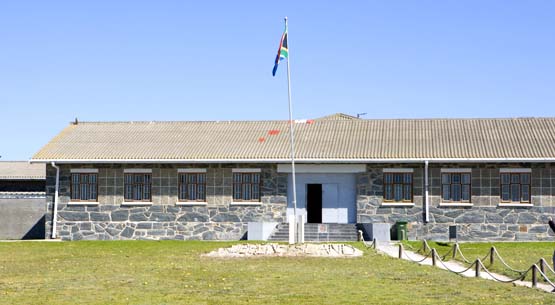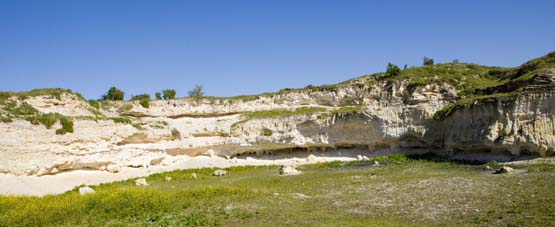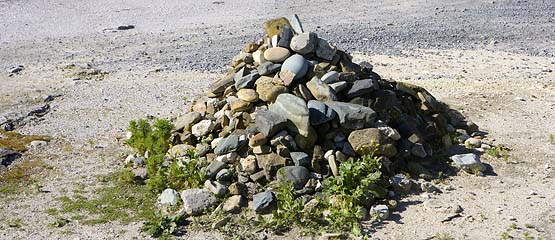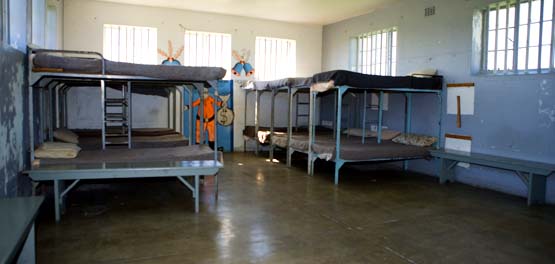Robben Island
Today was one of those days that you don’t only enjoy but feel truly privileged to have experienced.
We visited Robben Island today.
Robben Island is where Nelson Mandela and most of the political prisoners from the African National Congress (ANC) the Pan African Congress (PAC) and many of the smaller political parties, all enemies of the state of Apartheid, were incarcerated. Mandela spent eighteen years on this island in a tiny solitary cell.
Robben Island is just over seven miles, or a 25 minute ferry ride, out into Table Bay. Used for trade and a stopover point for trading ships making the journey around the Cape of Good Hope since the 15th century, it was first used as a political prison in 1658. The first prisoner was a man named Autshumato. He was exiled to Robben Island because he was reclaiming cattle he felt had been unfairly taken by the European colonists.

The Dutch controlled the Cape until 1795 when the British pushed them aside. The British decided to use Robben Island as a prison from this time forward and starting sending criminals of all sorts to the island. During this period of the 1800’s the British fought the Xhosa people, many of these people ended up on Robben Island.
By the late 1800’s the island became a hospital for lepers and the mentally ill as well as a prison. At this time everyone lived together regardless of why they were sent to the island. These conditions persisted until the 1930’s when the lepers were sent off the island and all the buildings were burned down because of the fear of lepresy. During WWII the island became a defense installation.
In 1948 the National Party established Apartheid in South Africa: a struggle that would continue until 1994. Apartheid was a system of separation of the races. Non-European people were not allowed to vote, study or have any freedoms that most of the modern world consider inalienable. The groups were African, Colored, Indian and White. The government controlled all aspects of life.
Resistance to Apartheid was dealt with through great force and terror. Government death squads killed many dissenters. Organized efforts against Apartheid came in tides. Each being put down with greater and greater force. The first wave arrived with the ANC Youth League which came together in 1949. In 1955, organizers such as Nelson Mandela, Walter Sisulu, Govan Mbeki, Ahmend Kathrada and many other brave men and women came together in Kliptown to write the Freedom Charter. This charter was a document that had inspiration from the anti-segregationist movement in the American South. Most of the leaders of this effort were eventually imprisoned on Robben Island in the early 60’s.
On 16 June 1976 hundreds of people died in a protest that began in Soweto. They were against the use of the Afrikaans language for Bantu (Black) education. The curriculum ensured that no person other than whites would receive an education of any depth or importance. Ultimately the Afrikaans kept each member of a racial class in their place. The uprising spread outside of Soweto to include the entire country. This event served as a seed to the end of Apartheid. Though it would take eighteen more years, it was this event and the policies that came out of the Apartheid regime that caused the world to sit up and finally take notice. Great force finally, began to gather against South Africa on the political and economic front through the 80’s.
Mandela was finally released from prison on Sunday, 11 February 1990, but not from Robben Island as he had been moved first to another prison in Cape Town and finally to one in Paarl a city north-west of Cape Town.
If one were to study and focus just on these events themselves, you would gain an understanding of the darkness that mankind is capable of. An important but depressing lesson. Instead, the political prisoners themselves, decided during those long and torturous years, that they would turn the table and make this period one of the shining examples of man’s struggle against tyranny and the good that can come out of struggle. This is the lesson that these men want us to take away and the one that moves me the most.
I decided to include all this background for you because if you don’t know these simple details (and there is far more to learn than what I have included, please don’t stop here) you couldn’t truly begin to understand how important of a trip this was for our family.
I lived in Lusaka Zambia in the early 80’s. This was the time a few years after the Soweto uprising against Bantu Education. The ANC ran an exiled political party from Lusaka while I lived there, led by Oliver Tambo. The current President of South Africa, Thebo Mbeki work alongside of Mr. Tambo during these years. I watched first hand as Rhodesia became Zimbabwe. All the countries along the Zambezi River were struggling. This is recent history for all of us, and has a touch of personal history for me directly. I have known of the struggle of Nelson Mandela for longer than I can remember. To watch my children walk into his cell on Robben Island was a crystallizing moment for me. It was like watching the Berlin Wall come down or living through the end of the Cold War.
We made the trip to Robben island this day because the weather was perfect. It was the nicest day we have had since being in Cape Town. Good weather is important, not only for the views, but the journey across the bay can be rough. It is common for the tours to be cancelled due to bad seas in the bay.
We took the 10am tour out, to return by 1:45pm. The modern catamaran made the trip painless for us, though there were a few people who turned green and used the motion sickness bags on the transit.
The island is barren. There really is not much about it as you approach that takes your breath away, except for the view it commands of the surrounding harbor back to Cape Town. A view that the prison was specifically designed to block from the prisoners in solitary, where Mandela lived. Our ferry slipped into the harbor quickly and effortlessly and our family was off first.
Extremely large 10 x 25 ft photos hang at the port showing prisoners arriving from years before. A gateway at the end of the pier frames your first peak into the prison grounds themselves. The air smelled of a clean sea with a little kelp, there was a light wind, and it was very quiet. It felt as if the calendar had just been pushed back forty-five years.

Two buses waited just before the gates to take us on an hour ride around the island. Visitors are not allowed to walk anywhere on the island except the prison itself.
Our tour guide did a good job getting everyone comfortable and off we went. Our guide did well relating his knowledge to us and had a calm demeanor that kept the topic of human struggle approachable. The highlight of the drive was the visit to the Lime Stone Quarry. It was here that Mandela and the other leaders did hard labor for many years. They worked eight hours a day, seven days a week making big rocks into little rocks. The dust created here damaged most of the prisoner’s eyes. Mandela had to have an operation to unclog his tear ducts, and he has scratches on his cornea from the dust. Today, you are not allowed to take a flash photograph of him because of this damage.

Our guide pointed out a curious pile of rocks at the exit of the quarry. It stood about 3 feet high and 5 feet in diameter. Everything else around it was barren. Our guide informed us after Mandela was released he came back to this quarry and gave a speech, surrounded by lots of other fellow prisoners. After the speech he silently broke away and walked over to the side of the quarry and picked up a small stone. He dropped it at the exit on his way out. Other prisoners noticed his behavior and one by one, did the same. All of this was unplanned. They haven’t touched the pile of rocks since.

After an informative bus tour of the island, and a quick stop at the southern tip to photograph Cape Town and Table Mountain across the bay, we were taken to the Maximum Security Prison. This was the prison for political prisoners only. Common criminals were kept on another part of the island.

Our guide changed here. Our new guide was himself a political prisoner for nine years. He blew up a police building in Johannesburg as a member of the MK, or militant arm of the ANC, the very arm that Nelson Mandela founded and led before his incarceration. Not one of the ANC leaders, he was kept in a communal cell with up to 145 other prisoners. He showed us how he slept and how the Red Cross eventually helped the prisoners gain beds on which to sleep.


Our guide also showed us the attached bathroom that was shared by all the men in this particular cell. It was in this bathroom, the only source of light at night, that the prisoners began to teach each other. It is the very place where the Minister of Defense, other government ministers, high court judges and other country leaders gained their education. An alumni role that Harvard or Wharton would be proud to have.

We took extra time as we left the cell to photograph this bathroom, only to find that our guide was nowhere to be found. About twenty of us were together with no sense of where to go next. It took almost five minutes but we finally found our way. Next stop was solitary confinement.
The ANC leadership was kept separate from the general political prisoner population for obvious reasons. Each was kept in a sixteen square foot cell. They had their own courtyard, with high walls so that no other prisoners could see them.
The courtyard had a tennis court size area in the middle surrounded by three walls with half of the cell building facing it to form the enclosure. The walls were so high you had no sense of the outdoors except for a blue sky above. Along the walls was a garden. This is where Mandela began hiding the first pages of his manuscript. Prisoners were allowed thirty minutes each day at breakfast, lunch and dinner in this yard. Otherwise they were in the cell.
Mandela was in cell four. He was lucky in a sense, because his room faced the courtyard, had a slightly larger window and received more sun. It was warmer. There were no bathrooms in these cells, only a metal bucket. The prisoners used this human waste to fertilize their garden.
The cell was small, the amount of people in our group was large. Each of us only had five seconds to stop, shoot a picture and ponder. I wish we had more time. As I mentioned earlier, it was more of an impact for me to see my kids enter the cell than myself. We had the foresight to bring our good flash just for this shot, but the stupidity not to ensure the batteries were fresh. By the time we got to Mandela’s cell I literally had one shot and one shot only until it died. As you can see, I did get it.

The tour finished quickly after this fly-by of Mandela’s cell. We walked back to the harbor, which was only two minutes away and were back on the ferry. The trip back was uneventful. I spent a lot of time pondering where we had just been and what we had just seen. More importantly I have been reminding myself since as to why this trip was so important.
History books are full of the terrible things men do to each other. It is too easy to think that our society, regardless of where we live on this globe, has moved past this sort of mindless abuse of each other. I don’t think that is true. Free elections were held in South Africa only eleven years ago. This is recent history, not ancient history. Anyone old enough to read this blog was alive when this madness was occurring. It still happens today. Just look around.
Tags: Apartheid, Robben Island, South Africa, Travel

Leave a Reply